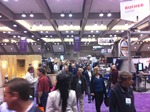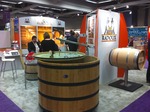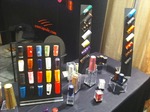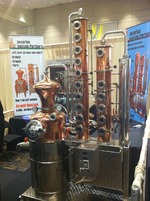 fermentaton,
fermentaton,  winemaking
winemaking  Wednesday, January 19, 2011 at 12:03PM
Wednesday, January 19, 2011 at 12:03PM Every day during harvest, the lab tech goes to each fermenting batch of wine and tests the level of Brix (a measurement of the percentage of sugar). As the wine ferments the Brix steadily drops until it reaches zero, indicating that all of the sugar has been converted by the yeast to alcohol. But occasionally during the fermentation, the chart hanging from the tank where the tech records posts the readings shows the same result day after day. That’s when you know you’re dealing with a stuck fermentation. The yeast has died off, become less active or stopped multiplying. Without treatment, the result would be syrupy sweet juice. It can be scary, but with the right techniques, a skilled winemaker can save the day. Our gold-medal-winning Buchigniani/Garcia Dry Creek Valley Zinfandel gets stuck every year because it comes in at such high Brix.
High Brix means high sugar and sometimes that creates a situation in which the yeast has made so much alcohol that before its finished consuming all the available sugar, the alcohol is high enough to kill the yeast. There are other reasons that primary fermentation can get hung up though. Sometimes the problem is as simple as the tank is too cold for the yeast, and they slow down quit doing their job. Occasionally a harmful bacterium from the vineyard such as Acetobacter or a mold such as Botrytis is producing acetic acids, increasing the volatile acidity and thereby disturbing the yeast. Sometimes there are not enough nutrients in the juice to sustain the yeast. In all cases, as soon as the winemaker has discovered that their wine is stuck, they immediately press the wine off of the skins so that they can better control the process.
Additionally, secondary fermentation (or malolactic fermentation), in which bacteria converts harsh malic acids to softer lactic acids, can outstrip the pace of the yeast. This is often the case with stuck fermentations and the procedure is to let the beneficial bacteria Oeonococcus and Lactobacillus run their course, at which point the primary yeast fermentation can be restored. The wine is then racked off of its lees before restarting the regular fermentation. Rice hulls (which are like the husks of rice grains) are added to neutralize harmful toxins in the juice.
The process of restarting fermentation varies from winemaker to winemaker. At Deerfield we begin by taking some of the wine from the tank and making a mixture of 50% wine, 50% water, fresh yeast, yeast food, and other nutrients which we then allow to start fermenting. This mixture is then added to the tank which is kept at 70⁰F and carefully monitored. When the Brix drops by half of what it was when it became stuck another mixture is prepared. This time the ratio is 75% wine and 25% water. Again when the Brix halves a final mixture is readied. The last mixture includes just wine from the tank and the remaining nutrients the yeast needs. The idea is to slowly acclimate the yeast to the environment of the wine so that it is happy, healthy, and well prepared to do its job. Usually this will resolve the problem and the fermentation will finish.
Maybe we can all learn something from the yeast: When you get stuck, take a bath, give yourself a fresh start, then slowly ease back into it and you’ll solve the problem in no time!
 fermentaton,
fermentaton,  winemaking
winemaking  Friday, January 28, 2011 at 2:24PM
Friday, January 28, 2011 at 2:24PM Living in the wine country, you meet plenty of oenophiles. It doesn’t take very long to realize that people who love to drink wine come from all walks of life. As a member of the Millennial Generation, it’s exciting to see so many young people becoming passionate about wine whether or not they’re in the industry. The process of discovery never ends. Throughout your life you can find new wines you adore, refine your palate and explore new sensuous gastronomic experiences. There is something magical however about the emergence of a nascent palate: The rebirth of a formative wine drinker into the Covenant of Dionysus.
During these tumultuous economic times, the wine industry has been on unsure footing. After all, as much as some of us think of wine as a necessity, in reality, it is a luxury product. Despite the tenuous atmosphere, the Wine Market Council reported last Friday that wine consumption grew in 2010, making this the 17 consecutive year of growth in the United States. Baby Boomers are drinking more wine and their choices are becoming more sophisticated, yet the driving force of the new growth is the younger generations. According to the Council’s 2010 Consumer Tracking Study, Millennials are drinking 34% more wine than in the past. Perhaps their palates don’t yet require wines from the upper echelons of price and quality. What is important is that they’ve discovered wine and what’s more, they like it a lot!
The Millennials are also interesting in that they’ve broken from historical patterns. They are increasingly choosing to drink wine over beer at a younger age than previous generations. While many Generation Xers are beginning to diversify in their wine buying habits, the Millennials’ tendency to show a willingness to try new things is leaving people wondering if tastes will quickly shift to higher price points. A Nielsen study of 7500 Millennials conducted in 2010 showed that generally they are more likely than other groups to equate product cost with quality.
Everyone knows that Millenials are the generation that is hooked in, with more people owning smartphones and having active social network accounts than any other segment. This should matter to wineries not just because of new tools available to them to spread the word, but because Millenials are more likely to plan their purchases in advance, which is a good fit for online buying.
The Wine Market Council expects continued growth in wine consumption this year, continued to be driven by younger generations. Deerfield stays on the cutting edge with an employee dedicated to reaching out to wine lovers around the world through the web. Deerfield has wines from $18 to $125 a bottles so that everyone can enjoy handcrafted luxury wines.
 marketing
marketing  Thursday, February 3, 2011 at 2:11PM
Thursday, February 3, 2011 at 2:11PM  Sacramento Convention CenterLast week I attended the Unified Wine & Grape Symposium in Sacramento, which is one of the world’s largest wine industry trade shows. I had a fantastic time learning about where the wine industry is at the moment, meeting people as excited about winemaking as I am, and checking out oenological and viticultural gadgetry I didn’t know existed!
Sacramento Convention CenterLast week I attended the Unified Wine & Grape Symposium in Sacramento, which is one of the world’s largest wine industry trade shows. I had a fantastic time learning about where the wine industry is at the moment, meeting people as excited about winemaking as I am, and checking out oenological and viticultural gadgetry I didn’t know existed!
 Inside a breakout sessionThe event is three days long and I attended the breakout sessions on Wednesday. I was able to catch the “State Of The Industry” address which looked generally at consumer trends and the industry’s reaction to those trends. The blog entry I wrote last week covered most of what was reported from the marketing perspective. It was also reported that in response to the public’s current fascination with Malbec and Muscato a huge amount of these varietals have been planted in the last year. It takes three years for a vine that has been “budded over” (had a new varietal grafted onto an existing rootstock) to produce grapes suitable for wine production.
Inside a breakout sessionThe event is three days long and I attended the breakout sessions on Wednesday. I was able to catch the “State Of The Industry” address which looked generally at consumer trends and the industry’s reaction to those trends. The blog entry I wrote last week covered most of what was reported from the marketing perspective. It was also reported that in response to the public’s current fascination with Malbec and Muscato a huge amount of these varietals have been planted in the last year. It takes three years for a vine that has been “budded over” (had a new varietal grafted onto an existing rootstock) to produce grapes suitable for wine production.  Inside the exhibit hallCurrently, 25% of Muscat vines planted in California are not bearing fruit. That means that if it turns out that the popularity of Muscat is a merely a fad then there will be a lot of frustrated growers in the year 2013.
Inside the exhibit hallCurrently, 25% of Muscat vines planted in California are not bearing fruit. That means that if it turns out that the popularity of Muscat is a merely a fad then there will be a lot of frustrated growers in the year 2013.
 Radoux Tonnellerie's boothThe barrel coopers’ booths were undoubtedly the fanciest at the event. One of the coopers had bought out 8 booths and actually built a living room in the middle of the event! Wine capsules of every shape and color were on display. Branded boxes made of fine paper were being shown alongside more practical wine shipping materials that looked like they could survive Armageddon. I knew that boxed wine is becoming more popular; with higher quality wines now being packaged in cardboard, but it wasn’t until I saw the vast selection of boxed alternatives that I realized how much is really out there.
Radoux Tonnellerie's boothThe barrel coopers’ booths were undoubtedly the fanciest at the event. One of the coopers had bought out 8 booths and actually built a living room in the middle of the event! Wine capsules of every shape and color were on display. Branded boxes made of fine paper were being shown alongside more practical wine shipping materials that looked like they could survive Armageddon. I knew that boxed wine is becoming more popular; with higher quality wines now being packaged in cardboard, but it wasn’t until I saw the vast selection of boxed alternatives that I realized how much is really out there.  Fancy wine capsulesThese days wine is even being sold in milk cartons and over-sized Capri Sun-style juice pouches. Speaking of alternative packaging, one company offered a one-way disposable substitute for a keg, which was like a giant Christmas ornament. I cringed at the idea of all the trash it created, though they certainly looked futuristic – huge baubles of wine! Deerfield, however, will continue to produce wine in the traditional manner: Wine bottles with natural corks.
Fancy wine capsulesThese days wine is even being sold in milk cartons and over-sized Capri Sun-style juice pouches. Speaking of alternative packaging, one company offered a one-way disposable substitute for a keg, which was like a giant Christmas ornament. I cringed at the idea of all the trash it created, though they certainly looked futuristic – huge baubles of wine! Deerfield, however, will continue to produce wine in the traditional manner: Wine bottles with natural corks.
 Barrel attachment for forklifts
Barrel attachment for forklifts Huge piece of vineyard equipmentOn the viticulture side of things I was impressed by the state-of-the-art equipment that exists to do virtually all the vineyard maintenance. These machines cannot replicate the care that a human being can give to each plant but some of the equipment can help a grower do the job better. For instance, vine tying can be a tedious and time consuming task. Sometimes the sheer repetition can leave a person dazed and unfocused. Showcased at this year’s Unified was a handheld device that a worker can use to automatically do the actual tying of the stem to the trellis.
Huge piece of vineyard equipmentOn the viticulture side of things I was impressed by the state-of-the-art equipment that exists to do virtually all the vineyard maintenance. These machines cannot replicate the care that a human being can give to each plant but some of the equipment can help a grower do the job better. For instance, vine tying can be a tedious and time consuming task. Sometimes the sheer repetition can leave a person dazed and unfocused. Showcased at this year’s Unified was a handheld device that a worker can use to automatically do the actual tying of the stem to the trellis.
 Beautiful European still for making GrappaFor me, the highlights of the oenological tools were twofold. There was another handheld device that could instantly analyze a cotton swab of a surface and tell you if it is completely sanitized. Around the corner was a fermentation tank, unlike any I’ve seen before, that closely resembled an egg laid by an emu the size of a small skyscraper. Its manufacturer advertised that the egg shape naturally promoted currents in the fermenting grapes, minimizing the need for laborious punch-downs and pump-overs.
Beautiful European still for making GrappaFor me, the highlights of the oenological tools were twofold. There was another handheld device that could instantly analyze a cotton swab of a surface and tell you if it is completely sanitized. Around the corner was a fermentation tank, unlike any I’ve seen before, that closely resembled an egg laid by an emu the size of a small skyscraper. Its manufacturer advertised that the egg shape naturally promoted currents in the fermenting grapes, minimizing the need for laborious punch-downs and pump-overs.
I had an absolutely fantastic and informative time at Unified this year and I’m looking forward to next year!
 wine events
wine events  Wednesday, February 9, 2011 at 10:01AM
Wednesday, February 9, 2011 at 10:01AM While there was snow on the ground in Dallas, Northern Californians were enjoying 80 degree weather this Super Bowl. Everyone has been relishing summer temperatures in the middle of winter and basking in the unexpected sun. As much as I like to be an optimist, this Cellar Rat is a little concerned about what this reprieve from cold weather might mean. The extended forecasts say our little block of summer is due to end next week. I for one am eager for more rain and I’d imagine the vines are too. My concern isn’t that they won’t get enough water – grapevines don’t need very much H2O and, in fact, less water produces better winegrapes. What I’m worried about is that the precipitation is simply being deferred and that we’ll have a particularly wet spring.
In this episode of Cellar Rat TV, I talked last spring about the potential of heavy rains during spring damaging the flowering buds and ruining the fruitset. If that happens then many bunches of grapes will only have some of their berries developed and come harvest, the pollenated “shot berries” will be a major problem to contend with. Too many of them in the fermenting must can cause astringent flavors or undesirable green notes.
The other challenge we face every spring is the threat of frost damage. Frost doesn’t damage the lignified (or wooded) parts of the vine but it can destroy or irreparably damage the cells of green growth. Therefore, I’d rather the vines face the cold weather now before they begin to bud than later in the season.
I’m no meteorologist but I would put my money on winter coming back with a vengeance. My apologies to those Californians who would rather be tanning than splashing in puddles, but I hope that we see some spring showers in the near future.
 vines
vines  Friday, February 18, 2011 at 3:21PM
Friday, February 18, 2011 at 3:21PM I give quite a few tours to folks who stop by and visit Deerfield’s wine caves. Sometimes people are surprised that it’s possible to make white wine from red grapes so I thought I’d take some time to set the record straight. The fundamental difference between red wine and white wine is that red wines are fermented while in contact with the grape skins. It’s true there are red and white skinned grapes. Chardonnay, Sauvignon Blanc, and Viognier are all white skinned grapes that are made into white wines. In the case of white wines, as soon as the grapes have been harvested and sorted they are immediately put into the press and the juice is transferred into a vessel (such as a barrel or tank) for fermentation. Some red colored grapes are also treated the same way. The most famous example would be Champagne. Shocking as it may be, that golden bubbly we’re so familiar with is derived from grapes as red as Pinot Noir. Fun fact: Currants, which are known for their dark hue, are dried Champagne grapes.
Red wines on the other hand are fermented along with the skins of red grapes, necessitating the use of punchdowns and pumpovers described in past articles. It is incredible how quickly the color is transferred from the skins to the liquid. During maceration (when the skins are crushed to release the juice), even if the juice is only exposed to the skins for 30 minutes it will develop a pinkish hue. There are several different methods for making rosé and one of them involves allowing a few hours of contact with the skins before pressing the grapes – that’s all it takes! For red wines, it’s only after the juice has fully fermented that the wine is drained off and the remaining skins are pressed.
Beyond coloration, there is a key component that separates red and white wines. One among many reasons that wine is unique among our beverage choices is that grapes contain tannins. Tannins are found in the stems, seeds and skins of grapes yet not in the “must” or the juicy meat of the grape. Tannins are found in oak as well, so a Chardonnay aged in new oak barrels does have tannin in it. A stainless steel fermented and aged Chardonnay would have little to none.
The only thing that prevents winemakers from making more white wines from red grapes is tradition. The now infamous White Zinfandel isn’t made from an offshoot of the Zin varietal with lighter skins. It’s just rosé made from regular Zinfandel grapes! In fact, when it was first created by Sutter Home in the 1970s it was an accidental product of a stuck fermentation. Though many people may not be reaching for White Zinfandel nowadays, we have its popularity to thank for saving California’s Zin vines so we can enjoy wines like Deerfield’s 2006 Old Vine Zin today. Experimenting can be fun and lead to some unexpected results. The wine I made this past harvest could actually be considered a White Pinot Noir!